 |
The Saint of the Day
St. Francis Borgia – October 10
Prof. Plinio Corrêa de Oliveira
Biographical selection:
For the Church, the 16th century was a dolorous epoch. The rebirth of Paganism, the spread of Protestantism and then Jansenism devastated Catholic Europe, while Islamism became an arrogant and menacing danger. In Golkun, Holland, 40 Catholics were martyred; in England St. John Fisher and St. Thomas More were beheaded, and Blessed Ignatius of Azevedo, along with his 39 blessed companions were massacred by the Calvinists on their way to Brazil.
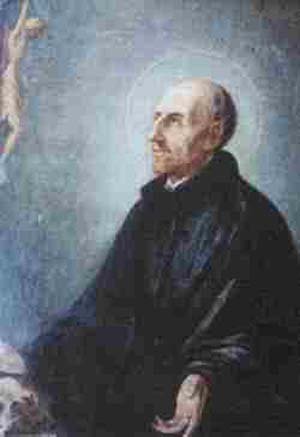
St. Francis Borgia, as General of the Jesuits
|
To remedy so many evils, Divine Providence raised up saints all over Europe. In Spain, St. Ignatius of Loyola, St. Francis Xavier, St. John of the Cross, St. Therese of Ávila, St. Peter of Alcantara, St. Paschal Baylon, and St. Thomas of Villanova carried out spiritual reforms that encompassed all Christendom. Others, such as St. Charles Borromeo, St. Felipe Neri, St. Peter Canisius, St. Francis of Paula, St. Jerome Emilianus and the great St. Pius V spread light over Christendom in their fight against the darkness of heresy.
During that stormy century, St. Francis Borgia shone for his nobility, virtue, and combativeness in Catholic Spain. He was born in Valencia into a family of royal blood that was related to the principal reigning houses of Europe, including that of Emperor Charles V. When Francis Borgia entered his service and came to court at age 17, the Emperor was so impressed by his noble and modest behavior that he determined to keep Francis always at his side. Charles V maintained this admiring friendship all his life.
After he became a widower, however, Francis Borgia made the decision to enter the Society of Jesus. St. Ignatius advised him to ask the Emperor’s permission. Since Charles V was in the Netherlands, Francis addressed a letter to him there. The Emperor replied with these words:
“I am very sorry to lose the company of a man of your merit, a shining light of counsel, a model in the exercise of the highest offices of State, and, because of your virtue and piety, a factor of edification for all my court. But I recognize that it would be unreasonable to dispute over you with the Master you have chosen to serve. It is, therefore, with sorrow that I grant you the permission you are requesting. I authorize you to renounce your fiefs and titles in favor of your firstborn son.
“The number of those who will envy you will be greater than those who will imitate you, since it is easy to admire beautiful examples, but difficult to follow them. I recommend myself to your prayers and I count upon you to attract divine blessings over me, my States, and all Christendom.”
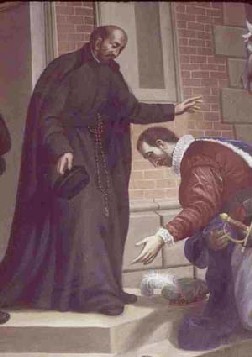
St. Ignatius Loyola receives St. Francis Borgia as Duke of Gandia
|
After holding the office of Superior of the Society of Jesus in Spain, Portugal, and the West Indies, St. Francis Borgia was elected the third General of the Order when Fr. Laynes died in 1560.
One of the first tasks he faced was that of refuting and fighting the calumnies that the Lutherans and other enemies of the Church were spreading about the Society of Jesus in attempts to bring it to ruin. They were trying to stimulate dissension between the Dominican Order and the Society of Jesus. When Cardinal Alessandrini, a Dominican, was elected Pope, a member of the College of Cardinals tried to influence him to suppress the Jesuits. St. Pius V answered:
“God preserve me from so great a sin. The Lord wants to use these priests for His glory. Their Society is called to produce great fruits for the Church.”
The next day St. Pius V was to be crowned Supreme Pontiff at the solemn ceremony in the Basilica of St. John Lateran. He was carried in the gestatory chair followed by all the dignitaries of the Roman Court. An enormous multitude filled the streets. When the cortege arrived in front of the House of the Society of Jesus, the Pope ordered it to stop. St. Pius V called for St. Francis Borgia, who respectfully approached. The Pope embraced him and offered his friendship and support for whatever he would need. He also thanked him for the service the Order had already given to the Church and expressed his warmest wishes to see their members work for the glory of God and the salvation of souls. The cortege then continued on its way.
Comments of Prof. Plinio:
This selection has two distinct parts. The first is a brief description of the life of St. Francis Borgia when he was a layman, and the second presents an episode from his government as General of the Society of Jesus.
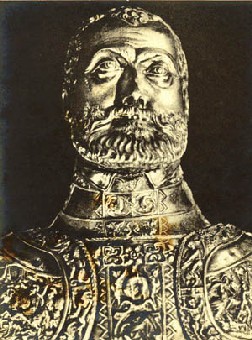
The Emperor Charles V,
the most powerful monarch of the age
|
To evaluate the biographical data in this selection, one needs to consider the general panorama of the times. His Sovereign was Charles V, Emperor of the Holy Roman and German Empire. He was Emperor, and also King of Hungary, King of Bohemia, Lord of numerous Italian territories, and King of Spain, and, therefore, of the Spanish colonies spread all over the world. It was at this time that it became common to say that the sun never set on his Empire. That is, when the sun was rising in one part of his Empire, night had not yet fallen in another. There was always daylight within the domains of his Empire.
He was one of the most powerful Monarchs in History. The 16th century was certainly already a decadent century in comparison with the Middle Ages, but it was not that distant from those blessed centuries, and many of its values were still alive at that time. One of these values was that people still appreciated justice more than power. It was generally recognized that Charles V, as Emperor, deserved the most honor and reverence. The Emperor of the Holy Roman Empire was considered the natural head of all Christendom, superior to all Kings. Above him was only the Pope.
St. Francis Borgia was a man of high lineage who descended from a royal family that had reigned over Valencia. The different kingdoms of Spain had united to face the Moorish invasion, and even though many of those royal families no longer had thrones, they were still very highly considered. St. Francis Borgia was a descendent of one of those families, which still had fiefs. His situation was similar to that of a prince.
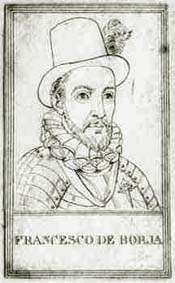
Above, the noble Duke of Gandiaand Marquis of Lombay; below, the Jesuit General
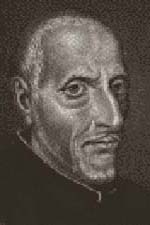
|
As a youth, he was sent to Charles V’s court. Since it was the highest court in the world, it attracted countless men of value: nobles, personages, famous artists, financial magnates, reputed diplomats, and brilliant military officers. It was a gathering point for the best of Europe. Over all of them was the Emperor, who successfully ruled over his numerous Kingdoms. Into this extraordinary scenario, an adolescent of 17-years entered. He was so remarkable that he attracted the attention of the Emperor. That is to say, he stood out among those countless princes and outstanding men who were there vying for the Emperor’s attention.
The selection tells us that he was very noble and modest, which means he possessed a great superiority and dignity in manners. We should not think of modest in the modern sense of the term, as describing a man who is trying to flee social life. Rather, the word would retain its old-fashioned meaning, coming from modus – that is, someone who had distinguished and reserved manners in his way of being.
The sanctity of St. Francis Borgia attracted the Emperor so much that he wanted him always near to give him counsel. St. Francis was Duke of Gandia, which he governed. He married and founded a large family with many descendents. That is, he had many temporal matters to deal with on a daily basis.
In 1539, the wife of Charles V, Empress Isabel, was struck with fever and died. As the Marquis of Lombay, Francis Borgia was required to head the funeral cortege to Granada, where a Requiem Mass was sung and official identification of the body was made before burial. When Francis opened the coffin and lifted the cloth from the face of the dead Empress, the cadaver had already begun to deteriorate. This sight made a strong impression on St. Francis Borgia, who realized the futility of all the glories of the world. He resolved to abandon them and ask St. Ignatius to enter the Society of Jesus.
One condition that St. Ignatius made was that he must obtain the Emperor’s permission. Then Charles V wrote him the beautiful letter we just read. It is a high eulogy of St. Francis Borgia, which ended with the line that expresses well the spirit of the time: Many people will admire you, but only a few will follow you.
This explains the difference between that time and the Middle Ages. In the Middle Ages, many admired the good examples, and many followed them. In the time of Charles V, many admired the good examples, and just a few followed them. Today the good examples are neither admired nor followed. You have here the different steps of the Revolution.
St. Francis Borgia entered the Society of Jesus and became its General. There was a rivalry between the two Orders: the Dominicans and the Jesuits. The enemies of the Church were interested in destroying the Society of Jesus because of its more zealous combativeness against the Protestants. So they stimulated rumors and calumnies that were spread against the Jesuits. When St. Pius V, a Dominican, was elected Pope, those same enemies found ways to influence Vatican ecclesiastics, who immediately tried to maneuver the new Pope to close the Jesuits. Instead, St. Pius V planned a way to do the opposite, to confer added prestige to their Order.
You know that until Paul VI, the Popes used the gestatory chair, which was a portable throne for the Pope carried on the shoulders of a dozen men so that the Pontiff could be seen by all the public. That custom, which began in the early days of the Church, was enriched as time passed with a ceremonial cortege and trumpets.
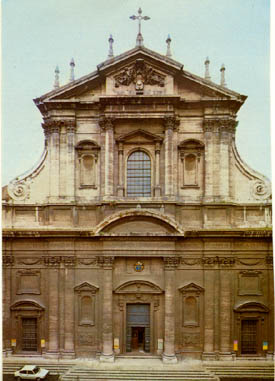
The Church of Gesù in Rome adjoins the Society's General House
|
St. Pius V resolved to break the long established protocol of the cortege of coronation. He did so, stopping its progression in front of the House of the Jesuits and calling for St. Francis Borgia, who most probably was standing outside with the other directors of the Society of Jesus waiting for the Pope to pass.
You can imagine the scene: St. Pius V, a man who had been Inquisitor, tall, thin, with a great sharp nose like an eagle, already advanced in years, sublime, approaching the highest phase of his life where he would shine brilliantly as the militant Pope who broke the Muslim power at the Battle of Lepanto. St. Francis Borgia, General of the Society of Jesus, with the air of a grand-seigneur beneath his Jesuit cassock. St. Francis Borgia approached the Pontiff with respect and admiration, venerating the Saint whom God had sent the world to be the Pope of the Church. He knelt before him, and St. Pius V bent to embrace him. Then they exchanged some words.
St. Pius V said that he loved the Society of Jesus with all his heart, that he wished every good for its priests, and that he considered himself its protector. His only desire was that the Society of Jesus fight for the glory of God. St. Francis Borgia thanked the Pope and promised the complete fidelity of the Order to St. Pius V and the Papacy.
Then the cortege continued on. St. Francis Borgia and his Jesuits entered the Church of Gesù, next to the Jesuit house in Rome, to make an act of thanksgiving before the Blessed Sacrament. What splendor, what an exquisite perfume emanates from the encounter of those two saints!
I think it is legitimate for us to turn our eyes from the contemporary epoch – filled with corruption and treason – to end the day admiring the encounter of those two saints. That encounter, the words they exchanged, and their mutual admiration for one another express something of the supreme happiness we will have in Heaven.
Let us ask St. Francis Borgia to give us his Catholic spirit, which impressed everyone in his life, including Emperor Charles V, and his dedication to the Papacy, which was the main characteristic of the Society of Jesus in its first times.


  | | Prof. Plinio Corrêa de Oliveira | |
The Saint of the Day features highlights from the lives of saints based on comments made by the late Prof. Plinio Corrêa de Oliveira. Following the example of St. John Bosco who used to make similar talks for the boys of his College, each evening it was Prof. Plinio’s custom to make a short commentary on the lives of the next day’s saint in a meeting for youth in order to encourage them in the practice of virtue and love for the Catholic Church. TIA thought that its readers could profit from these valuable commentaries.
The texts of both the biographical data and the comments come from personal notes taken by Atila S. Guimarães from 1964 to 1995. Given the fact that the source is a personal notebook, it is possible that at times the biographic notes transcribed here will not rigorously follow the original text read by Prof. Plinio. The commentaries have also been adapted and translated for TIA’s site.
|
Saint of the Day | Home | Books | CDs | Search | Contact Us | Donate

© 2002- Tradition in Action, Inc. All Rights Reserved
|
 |

|